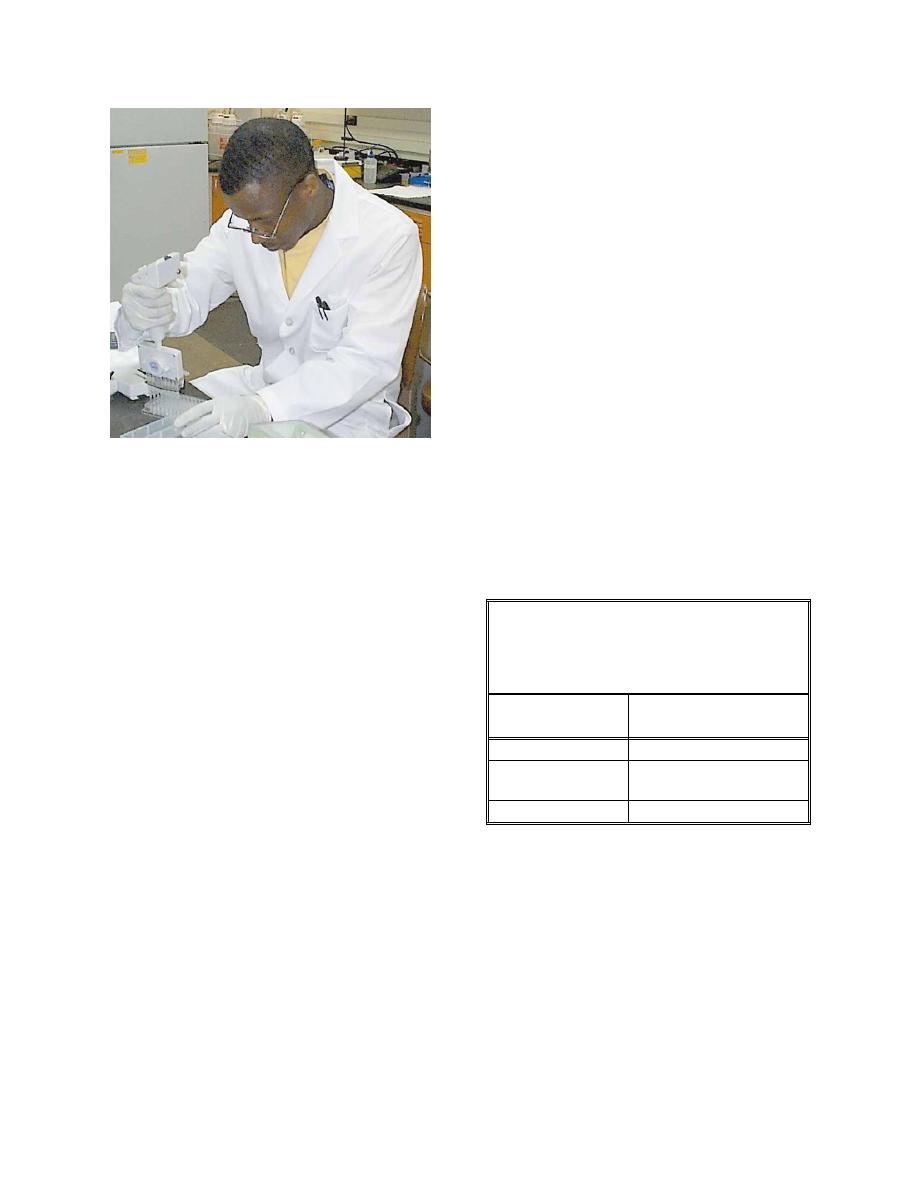 |
||
|
|
||
|
Page Title:
Figure 3. Adding reagents to a 96-well plate using a multichannel pipet |
||
| |||||||||||||||
|
|
 ERDC TN-DOER-C10
March 2000
25 percent and the expendable supplies cost by
about 65 percent compared with the 6-well plate
method, and produce a slight increase in sensitivity
(Table 1).
Significant additional savings in time and cost were
gained by modifications to the extraction method.
Combining the SA/SG cleanup step with extraction
reduced sample preparation time from 17 hr/sample
to 2.5 hr/sample with no loss in extraction effi-
ciency. The extraction efficiencies were deter-
mined for both ASE and ASE one-step methods
using 3H-TCDD and were found to be similar:
87.2 1.8 percent recovery for the standard ASE,
and 80 6.2 percent for the ASE one-step method.
An additional advantage of the ASE one-step
Figure 3. Adding reagents to a 96-well plate
method is that the amount of waste solvent requiring
using a multichannel pipet
disposal is reduced from 270 mL/sample for ASE
with separate cleanup to 130 mL/sample for ASE one-step. The efficacy of SA/SG removal of PAHs
for the two methods was tested by spiking a clean sediment with a PAH standard prior to analysis
with the H4IIE cell line. No response due to PAH addition was detected after cleanup with either
method (Table 2).
To test whether samples containing high levels of
Table 2
PAHs could overload the SA/SG column and allow
H4IIE Maximal Responses of
PAH breakthrough, a harbor sediment highly con-
PAH-Spiked Sediments Extracted
by ASETM
taminated with PAH was extracted with the ASE
standard method, resulting in an extremely high
Response, ng
TEQ (15,125 2,850 pg TCDD TEQ/g dry sedi-
resorufin/g protein
Method
ment, n = 5), which dropped to below detection
ASE, no cleanup
540
limits following SA/SG column cleanup. Spiking
ASE, with SA/SG
Below LOD
the extract with PAHs prior to column cleanup did
cleanup
not affect the results, indicating that the SA/SG
ASE one-step
Below LOD
column was not overloaded. Extracts of the same
sample prepared by the ASE one-step method did
not produce any detectable TCDD TEQ as
measured by the H4IIE cell-based assay, indicating
that this method is as effective in removing
PAHs as the more laborious column cleanup.
CONCLUSIONS: The ASE one-step extraction/cleanup procedure in combination with the
96-well plate adaptation of the P450RGS assay provides a very cost-effective and rapid alternative
to conventional analytical chemistry for screening sediments for dioxin and dioxinlike activity. By
scheduling the separate operations properly, it is possible for one person to extract and test three
replicates of 24 sediment samples in two workweeks. PAHs in sediments may also be assayed using
these methods. These methods are currently being applied in a field demonstration in which a
Federal channel with a historic point source of creosote contamination is being dredged, and samples
4
|
|
Privacy Statement - Press Release - Copyright Information. - Contact Us - Support Integrated Publishing |